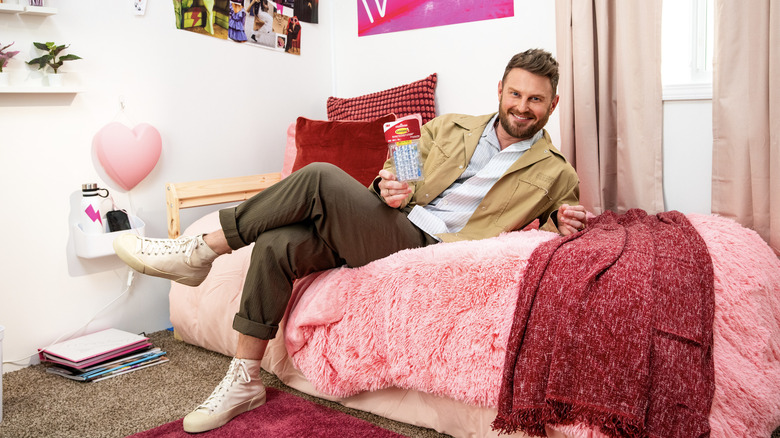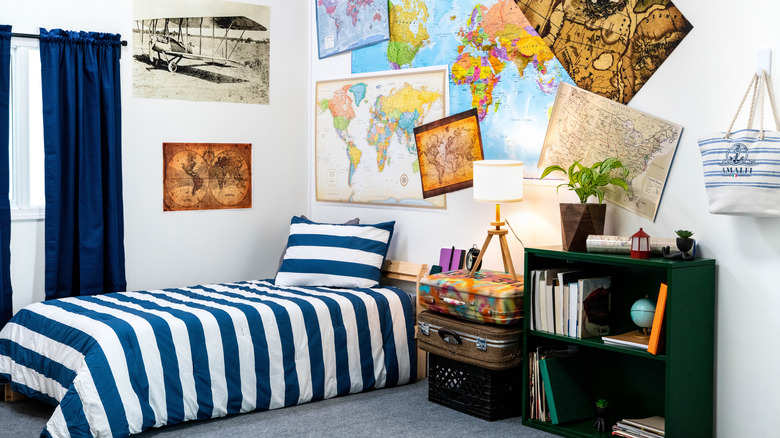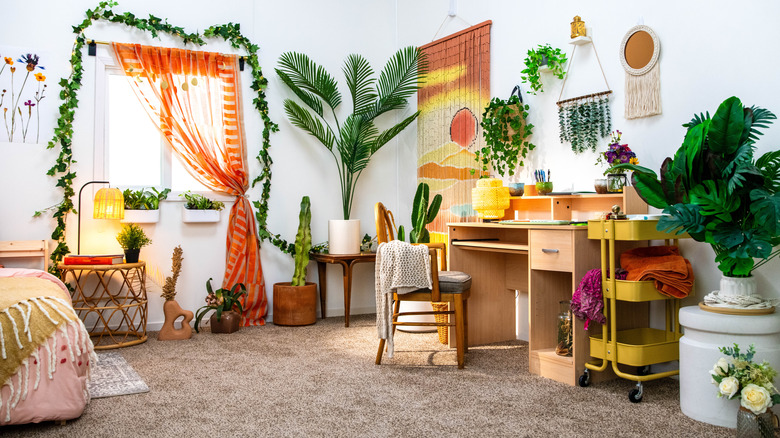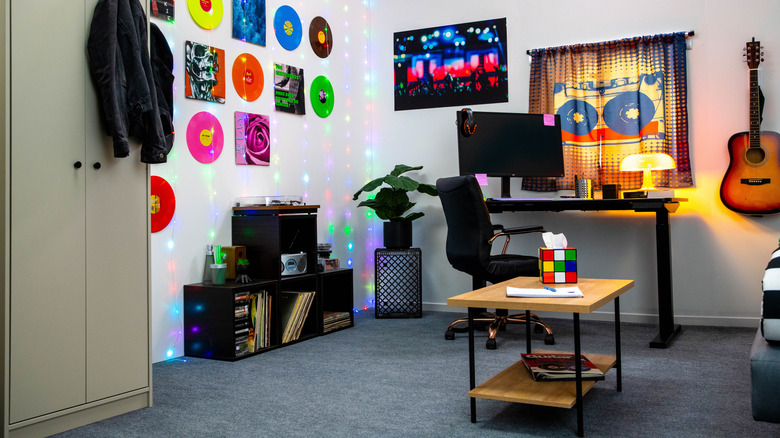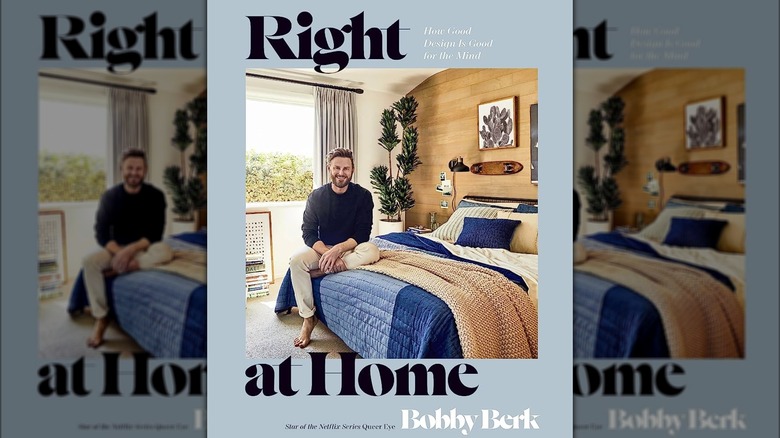Queer Eye's Bobby Berk On How To Design Your Dream Dorm Room - Exclusive Interview
If the idea of designing a dorm room sounds daunting, interior designer Bobby Berk is here to save the day. The "Queer Eye" star believes that anyone can easily make a small living space into a home that perfectly encapsulates who you are — even if you aren't allowed to express yourself with paint colors or nail anything into the walls.
Berk has recently partnered with Command™ Brand to prove to everyone that personalizing your space — no matter how small — can be easy as long as you have the right products. Between the brand's hooks, strips, and clips, there are endless ways to express yourself in a small living space, and Berk sat down with us to explain exactly how you can use them to create the dorm room of your dreams.
During the exclusive interview with House Digest, the interior designer shared his favorite trends when it comes to dorms, detailed exactly how to decipher your unique design style, and told us the unexpected impact that an unorganized space could be having on your mental health.
His top design tips for working with a small living space
Command™ Brand has officially named you their first Director of Dorm Design. What are the most important tips to keep in mind when decorating a small space such as a dorm room?
It's all about making sure that things are doing double duty and utilizing your real estate — not just your floor space, but your wall space, your door space. [It's] doing things that are double duty. If you're going to bring some extra seating in, bring in a storage ottoman. That way, it's seating, but it's also storage, store-organization. I accidentally said that earlier, and I was like, "I just made up a new word: store-organization." [Laughs]
Then utilizing your wall space ... The great thing about Command™ products is you can hang things on the wall without leaving damage, and you don't need any tools. That's one con about a dorm room — I'm sure there's a lot — but the biggest one for me is that you're not allowed to paint. You're not allowed to put any holes in the wall, so basically, they're like, "You can't have any personality in this room at all," but with Command™ strips, you can.
For years, this is all I thought of them as — just as strips, so that way you can hang up posters or small things. But they actually now have strips that will hold up to 20 pounds. They have hooks that'll hold up to 15. You can actually put up little shelves, you can put up mirrors, clocks, dry-erase boards — not just posters now. You can really make your space your own.
One thing that I've been recommending is [that] you can't paint the walls, you can't put up wallpaper, but you can put up fabric. Go to a fabric store and get a cool fabric that you like in a print or a solid, and you can use Command™ strips to put it up at the top of the ceiling, and it creates nice fabric panels on the wall. That way, not only can you get some color and texture in the room, but it also helps with acoustics.
What are some other unique ways to use Command™ Brand products in a space?
Like I was saying before, Command™ Brand isn't just about Command™ strips. They have products that help you hang and utilize all kinds of different things.
Two of my favorites are the 20-pound strip, because again, you can put up little shelves, you can put up those little troughs where you can organize all your bathroom stuff and put it on the wall. Also, the hooks that you can hang your clothes on, that you can hang your book bag on — they'll hold up to 15 pounds. You can line those up on the back of your bathroom door or your dorm room door on the wall, and you can utilize that real estate from top to bottom, not just left to right.
His favorite dorm design trends for fall
What are some of your favorite dorm design trends for the upcoming fall that you were able to incorporate in the four dorm designs that you created for Command™ Brand?
We did four different looks: We did the Boho Plant Daddy, or Plant Mama — Plant Parent, actually; we won't gender it — and it's all about bringing in neutral tones, and greenery, and textures. Boho has been popular for quite a few years now. I don't know if you know Justina Blakeney from Jungalow. She made it very popular, and I love it. She brought it back, and she made it very chic.
The Retro Music Lover — setting up your space with all the music that you love is very important. College is one of those times when you figure out who you are, and music is a big part of that.
The World Traveler — I love having up maps. When we were setting up the space, I actually found myself, in between shots, standing there and staring at the maps and realizing there's so many countries that I didn't know existed, and I'm pretty good with world geography — oh, my accent fell out there for a second. [Laughs] I'm pretty good with geography, but I remember standing there and looking at some of the little countries in Africa going, "Oh, my God. I've never heard of this country. I feel so dumb." Having a map up there when you're laying there staring, you learn. I love decor that helps you learn.
Then, for our fashionistas, the Super Glam one — it's all about personal style, disco balls, pinks, and blues.
Are there any current dorm design trends that you wish would go away?
For me, a space is all about you, what makes you tick, and what makes you happy. If there's something that I personally don't love, and I don't think is great, if that's what makes you happy, go, do it. Because your space should spark joy for you. It should make you thrive. It should make you happy. It's all about what you like, not what I think is bad or good.
Where to begin when it comes to discovering your true design style
I think the hardest part for most people is trying to figure out how to approach designing a new space. What would you say is the best place to start when trying to determine how to tie together pieces that not only reflect your true design style, but also your current era in life?
One of the things that I talk about in my upcoming book, "Right at Home," is how to figure out your design style. It's not about, "Oh, what's my design aesthetic?" because often, it hasn't turned into a specific aesthetic yet.
It's all about thinking about the things that you're passionate about in other aspects of life, like what's your favorite article of clothing? If it's a flannel plaid shirt, you'll probably like some plaids in your design. If it's a leather jacket, you'll probably like some leather accents in your design. If it's a chunky cable knit sweater, you're probably going to like some chunky cable knit pillows or throws. Think about the things in life that make you passionate.
Years ago, we had a hero on our show ["Queer Eye"]. He didn't know what his design aesthetic was. He was 27. He was young. He had inherited his grandmother's house that was super glam. I'm like, "What's your favorite show?" He was like, "'Madmen,'" and I'm like, "Okay, '50s, mid-century."
I'm like, "What's your dream vacation?" He's like, "Cuba," and I'm like, "Also, '50s, mid-century."
I did his home in a mid-century modern look with a mural of Cuba and big palm tree plants. He walked in, and he's like, "Oh, my God. This is me. This is my design aesthetic. How did you figure that out?" I'm like, "I asked you about things you were passionate about."
That's where you should start. You should start with the things that you're passionate about. Your space is going to evolve from there, and it's going to be a space that helps you recharge.
The unexpected impact your home can have on your mental health
Your new book, "Right at Home: How Good Design is Good for the Mind," is coming out on September 12. What do you think would surprise people the most to know about the connection between design and mental well-being?
A lot of times, people don't think about the little things around their home that can have a big effect on their mental health outside of their home. For example, in the beginning of the book, we talk about what I was saying — figuring out what your look is. Then we go into organization of the home, and little things like making your bed in the morning. A lot of people are like, "Why do I need to make my bed in the morning? I'm crawling back into it in the next three to 16 hours. What's the point?"
But senses of accomplishment release endorphins, and if you don't think about making your bed as an accomplishment — "I accomplished something" — subconsciously, you do. You told yourself you wanted to make your bed, and you made your bed. Inside, you're getting these little endorphins of, "I accomplished a goal that I had." Mind you, it's a small, tiny little goal, but you accomplished a goal you set out to do, and that releases endorphins.
It starts to roll into when you go downstairs to take care of your kids or your dog, like, "Oh, another simple accomplishment." By the time you get to work, you feel like you can accomplish anything, because you've already started out your day achieving a goal.
On the other hand, when you don't do that thing that you said you were going to do — when you don't make that bed — that's a small subconscious failure. "I didn't do what I said I was going to do." That whole attitude, that mentality, that mindset goes into work. You get to work, and you already subconsciously have this little notch of a failure on your day. It's the same with laundry. "How's the laundry on the floor?" You go to bed at night, and you look over, and you're like, "I didn't do that laundry I promised myself I was going to do."
Again, a little notch — a small, little subconscious notch of a failure, something you didn't succeed at. The next morning, you wake up. The first thing you're confronted with when you open your eyes is that pile of laundry that you didn't do. Again, subconsciously, a little notch of, "I didn't accomplish this." That goes again when you get to work. "I started my morning out feeling unaccomplished, and it rolls into my attitude when I get to work."
Little things like that will help people to start thinking about how it affects their life. We talk about lighting, we talk about color theory, plants ... There's even a chapter in there about how to help people — or even if it's yourself — who have experienced a loss, be it a spouse or a child, and how to help them figure out how to fix their spaces and edit that person out of the space, but also retain the memory of that person in the space so that they're able to move on.
The number one design question Bobby Berk gets asked the most
Over the years, I'm sure fans have reached out to you asking you lots of specific questions about design. Is there one question that you find them asking you the most?
If I can design their space. [Laughs]
I figured that it was probably, "Can you come into my house and fix this?"
Yes. I also get — so often — some people send me DMs, and they're like, "What color should I paint my space?" I'm like, "I don't know ... I don't know anything about you. That's a very loaded question." I'm like, "Fuchsia? Fuchsia!" I get a lot of questions that are questions that, without knowing anything about the person, I cannot answer.
To see Bobby Berk's dorm room designs and to hear more tips, be sure to follow @Command on Instagram. Check out Command™ Brand's website to learn more about the company and its products.
This interview has been edited for clarity.
